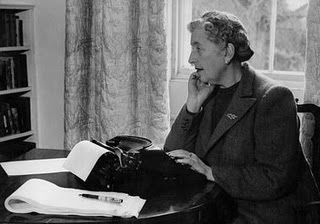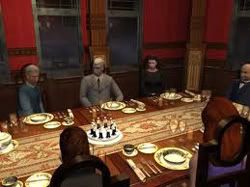Book Review: Agatha Christie’s Secret Notebooks by John Curran
During her amazing half-century-plus writing career, author Agatha Christie jotted notes and ideas for her work in various notebooks and journals. Seventy-seven of these notebooks were discovered by her heirs after her death. Although they are certainly not a complete collection of the scribblers she used, they shed much light on how Christie created her masterpieces.
 The notebooks contain character lists, suggested settings, and plot ideas and development, but until now they have been largely ignored, mainly because Christie’s handwriting is nearly illegible. As John Curran worked with the material in preparing Agatha Christie’s Secret Notebooks: Fifty Years of Mysteries in the Making
The notebooks contain character lists, suggested settings, and plot ideas and development, but until now they have been largely ignored, mainly because Christie’s handwriting is nearly illegible. As John Curran worked with the material in preparing Agatha Christie’s Secret Notebooks: Fifty Years of Mysteries in the Making, he became familiar with her scribbles and unlocked fascinating insights into the woman and author Christie.
The Secret Notebooks opens with several chapters of summary, giving an overview of Christie’s work, her characters, and her influences, among other things. These chapters I read completely.
I learned why Christie was so successful and remains so popular. She was immensely productive and eminently readable. Curran also points out the secret of the plots that entrance Christie’s readers:
The secret of her ingenuity with plot lies in the fact that this dexterity is not daunting. Her solutions turn on everyday information–some names can be male or female, a mirror reflects but it also reverses, a sprawled body is not necessarily a dead body, a forest is the best hiding place for a tree. She knows she can depend on our erroneous interpretation of an eternal triangle, an overheard argument or an illicit liaison. She counts on our perceived prejudice that retired Army men are harmless buffoons, that quiet, mousy wives are objects of pity, that all policemen are honest and all children innocent. She does not mystify us with the mechanical or technical…
In almost every Christie title the mise-en-scene features a closed circle of suspects–a strictly limited number of potential murderers from which to choose. A country house, a ship, a train, a plane, an island–all of these provided her with a setting that limits the number of potential killers and ensures that a complete unknown is not unmasked in the last chapter.
He also touches on what I have always considered a touchstone of a good mystery book – the fairness.
Throughout her career Christie specialised in giving her readers the clues necessary to the solution of the crime. She was quite happy to provide the clue, firm in the knowledge that, in the words of her great contemporary R. Austin Freeman, ‘the reader would mislead himself’.
The bulk of the book, however, discusses the notes on individual books and contains many spoilers. I found interesting the comparison of plots and plot devices, and settings in various books.
Last fall, I read several of Christie’s novels, checking Fantastic Fiction to find the titles of her earliest works, and thinking to start at the beginning of my collection. I thus completed The Mysterious Affair at Styles (1920), The Man in the Brown Suit (1924), The Secret of Chimneys
(1925), Partners in Crime (1929), and Sad Cypress
(1940). Reading the plans behind these, and Curran’s intelligent analysis of Christie’s background work, was fascinating.

I borrowed Agatha Christie’s Secret Notebooks from the library, but I want to buy a copy for own bookshelf. I plan to put it beside my collection of Christie’s works and to consult it upon finishing one, when the characters and plot intricacies are fresh in mind. As Curran points out: it is possible to read a different Christie title every month for almost seven years; and at that stage it is possible to start all over again safe in the knowledge that you will have forgotten the earliest.
And so Christie’s work continues to transcend every barrier of geography, culture, race, religion, age and sex; she is read as avidly in Bermuda as in Balham, she is read by grandparents and grandchildren, she is read on e-book and in graphic format in this twenty-first century as eagerly as in the green Penguins and The Strand magazine of the last. Why? Because no other crime writer did it so well, so often or for so long; no one else has ever matched her combination of readability, plotting, fairness and productivity.
And no one ever will.
Amen to that.
Links for my Canadian readers:

Agatha Christie’s Secret Notebooks: Fifty Years of Mysteries in the Making
The Mysterious Affair at Styles: A Hercule Poirot Mystery
Secret Of Chimneys: a Hercule Poirot Mystery
Sad Cypress: a Hercule Poirot Mystery
P.S. If you click through the affiliate links in the book titles, you may notice a different cover. I like to see the cover that’s on the copy I read – and it’s usually different than Amazon.com because they display the American release, and I read the Canadian. Again, the links are affiliate links so I will receive a small percentage of any purchase you make after clicking through from this blog.



[…] Colleen at Books in the City (Secret Daughter)46. Darren @ Bart’s Bookshelf (Awaken)47. Debbie Rodgers – Exurbanis.com (Agatha Christie’s Secret Notebooks)48. Debbie Rodgers – Exurbanis.com (The Mark of the Lion)49. Diary of an Eccentric (The Poets […]
This really *does* make you want to read them all over again, doesn’t it?
Yes, Karen, it really does. Her early books are not only good, they’re interesting as she decides on her ‘heritage’ characters.